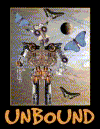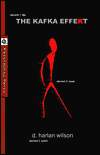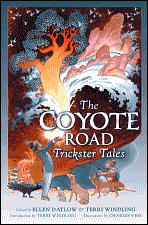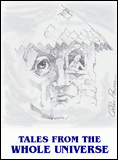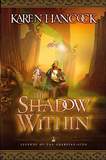
Close Encounters of the Urban Kind, edited by Jennifer Brozek
Book Review by Joshua Palmatier
Have you read this book?
The theme of this anthology is to use an urban legend-either something
well-known, something made up, or something local to a particular
region-and give it an alien twist or alien explanation. In other words,
involve aliens in some way. I was invited to participate in the
anthology and had fun writing my own version of that theme. Here are my
thoughts on the rest of the stories in the anthology.
Lollo by Martin Livings: This is a take on the "babysitter with someone in the house" legend, twisted together with the "evil toy clown" legend. I found the main characters interesting, and loved the overall idea and some of the nice touches (such as the main character being mostly deaf), and the element of horror made me cringe, but in the end there was one simple element, easily fixed, that kind of ruined the story for me. When the characters were fleeing, trying to get out of the house, they run into a deadbolt and can't escape because they need the keys. . . . But deadbolts aren't locked with a key from the inside (not that I've ever seen).
Green Tears on Black Velvet by Jeff Soesbe: This story used an urban legend I hadn't heard of: the "crying boy painting" legend from Britain, where a bunch of fires with paintings of crying boys in the burnt remains set in a kind of panic for those that owned such paintings. The main character is a fire investigator and this story does a good job of mixing the crying ALIEN paintings in with the investigator dealing with his divorce and how it affects him and his son. A good story, and the author handles the mysterious aspects of the paintings well.
Racing Lights by Erik Scott de Bie: A take on the "headlights following you" while you drive down the highway legend, always in your rear view mirror. I know I've been creeped out by a car that appears to be following me late at night. Here, the main character is a teenager who likes to race cars, and the lights (initially) are street lights he uses to judge when he can safely make a hazardous turn. Of course, when he's out late one night, in a strange mood, and those light appear to follow him . . . well, trouble ensues. An interesting story.
Waterheads by Ivan Ewert: Here, the legend is one about a mysterious section of woods near a bridge, the idea being if you're there late at night, then the "Waterheads" that live in the area will get you. I liked the characterization of the teenagers in this one, but felt that the ending was a little predictable.
The Fingernail Test by Bev Vincent: This one plays with the idea/fear that we are constantly being watched, through hidden cameras and one-way mirrors. Mostly, we think of the watchers as being the government in some form, but of course this is an anthology about aliens, so . . . Here, the main characters are criminals on the run and hiding out in a skanky hotel. Paranoia sets in after they've been there for a few days and one of them starts obsessing about the mirrors in the hotel room. Of course, is it really paranoia when it's true? I liked the tone and feel of this story.
Headlights by Jennifer Pelland: Another headlight story, although here it's about driving around with your headlights OFF and killing the people in the first car that flashes their lights at you. Apparently this was a gang initiation ritual at some point. This story also plays with the idea that sometimes your opinions of the friends you made early in school change as you progress through high school . . . and sometimes you should give your friends more credit. A good story. I liked the idea that the characters are shocked at one of the decisions made during the course of the story, but I'm not sure I like the very end of the story, the way the characters react to the events overall.
Shiny Eyes by Jonathan McKinney: This is a boogeyman story-the "shiny eyes" part-mixed with the idea that maybe those doodles in that borrowed textbook from school are more than they seem. This story was different from the others in that it was set in our world . . . sort of. There was an obvious twist to the world, with the characters living in a small community with certain specific rules they had to follow, such as taking their pill every day. So of course our main character starts defying those rules with not so favorable outcomes.
The Invitation by Carole Johnstone: The setting for this one is across the Pond and plays off of the idea that the "bad thing," whatever it may be, can't come into the house unless invited. Here, the "bad thing" comes during storms and can be invited into the house through mirrors and other reflective surfaces. When the main character's grandmother insists he help her cover the mirrors, he does so . . . but scoffing at her at the same time. His derision doesn't last long. I really liked the feel of this story, and how it ends. It was a little rough getting into, but a good story.
Frames of Reference by Nathan Crowder: We've all heard about those snuff films supposedly out there, where someone is killed on camera for "entertainment." This story starts with the main character asked to determine how a particularly gruesome and realistic piece of film could have been faked . . . if it's been faked at all. As the story progresses . . . well, I don't want to spoil the twist, so I'll stop there. I really liked how the author inverted another common myth and combined it with the snuff film idea. I'm a little iffy on whether I like how the story ended though, its only drawback.
Late Night Snack by Robert Farnsworth: Another headlights story, this time a couple headed to Vegas is followed by a mysterious black SUV. When the SUV turns aggressive . . . well, the plot picks up its pace. I thought this story took too long to get started and I had trouble connecting to the characters, although I liked the idea behind the SUV.
Two Out, Wendigo by Rosemary Jones: An urban legend out of the Midwest this time, about how wendigo infects people with insatiable hunger. It's mixed with the "curse of the billy goat," which supposedly explains why the Cubs haven't played in a World Series for 60 years. I liked the story and the main character. I did feel that there were some unanswered questions at the end of the piece though, and the solution to the wendigo seemed a little . . . easy. I don't see why it didn't immediately spread after that. But still a good story.
The Hippie Monster of Eel River by Shannon Page: Some good characterization here, the main character coming across strong and believable. The urban legend is made up, but it follows the familiar boogeyman in a specific location theme well enough that it's instantly believable. And in the vein of the original episodes of the X-Files, the set-up is such that you can either believe that the events actually happened and were alien in nature . . . or that there's a perfectly plausible explanation, in this case drug-induced hallucinations. This set-up left the ending kind of open to interpretation.
Roadkill by Rick Silva: I hadn't heard of this cardboard box legend either-where someone driving a car swerves to hit a cardboard box or pile of leaves, for fun or in anger, only to find out that a kid had been playing in the box of leaves. I think this idea is horrific because it's so easy to see it occurring. We have an alien twist on it here, which makes the unintended consequences that much more terrible for the main character, but I think this story would have been horrific enough even without that. Well written and certainly made me think long after the story finished.
End of Life by Richard Lee Byers: The urban legend here is based on much more recent events, the idea being that the government may send out suits to counsel the elderly on ending their life, perhaps with assisted suicide. In the story, the suits show up merely to take a survey . . . but of course the suits are more than they appear. This was much more a psychological horror story than most of the others in the anthology so far and certainly creeped me out a bit because of that. Hard to say more without ruining part of the story though. Well written.
Teacups and Saucers by Ramsey Lundock: This one used about ten different urban legends all thrown into one, to the point that I felt it would have been a better story if there weren't so many different things going on. There were crop circles and flying saucers and secret bases, etc, etc, etc. The main idea-that perhaps the aliens aren't what we think they are-was a cool idea and I wish more time had been spent on developing that. I really felt this story needed more space, so that all of the connections the author was making would have had more depth to them and could have been revealed at a slower pace.
Gloomy Sunday by Eddy Webb: A really good story about how there could be subliminal messages in music, and that music could be used to control us. Here, the urban legend is that a particular song called "Gloomy Sunday" would actually cause you to commit suicide. I liked the feel and set-up of this story, with the main characters being ex-Army, one who got out completely and the other who went on to join the secret government group. I thought the relationship between them was worked in well.
Mastihooba by Joshua Palmatier: OMG! This is the bestest story ever written! Get ready Pulitzer! . . . But I may be slightly biased since I wrote it. It's the first short story I've written in years. I used a local urban legend about a vagabond who used to go from bar to bar promising work for drinks. He'd get the drink, but never perform the work, so became something of a legend. Somehow, that morphed into a boogeyman kind of story, the man used to scare the local children into behaving. I gave it an alien twist that I thought was cool. I hope you all enjoy it. I certainly had fun writing it.
I Am Sorry For Talking So Rarely to Strangers by Alma Alexander: I wondered if anyone would do a take on the Mothman urban legend and here it is! A completely different take, of course. This story is more about the alien perception of the story and how sometimes "alien" is ingrained in us by society, along with the fear it engenders. A fairly quiet story, compared to the rest of the selections in the anthology, but well written. I like that in the end, it wasn't so much about the Mothmen as it was about the main character and her relationship with her mother.
Dead Letter Drop by Pete Kempshall: Here the urban legend is about a blind man who supposedly lured young women to their deaths during the food shortage after World War II. I hadn't heard of this legend, so went into the story blind. (Haha.) It certainly drew me in with the bombed out city of Berlin and the young main character fighting to survive there. Very well written and I loved how it wasn't what you were expecting in the end.
It Came From the Backseat by Eric R. Lowther: This is a grand old story in the style of a B-movie, using the obvious urban legend of having someone hidden in the back seat of your car without you knowing it. Mix in a little MIB black suits (sort of) and a main character who doesn't take shit from anyone after a bad day overall, and you've got a rollicking story. If you take it like that, all tongue-in-cheek, it's a good read. My only issue was that there was some serious head-hopping-meaning we start off almost exclusively in Mary's head, for a long while, but then we start getting thoughts from other characters at random. While omniscient unlimited is a valid POV, it's not one that I like much. But if you can set that aside, good story.
So, as with any anthology, I thought there were some really good stories in here, and others that I thought needed a little tweaking. Overall a good anthology though. I enjoyed reading what all of the other authors came up with regarding an urban legend with an alien twist, and really liked some of the twists on the obvious way to use that theme.
Lollo by Martin Livings: This is a take on the "babysitter with someone in the house" legend, twisted together with the "evil toy clown" legend. I found the main characters interesting, and loved the overall idea and some of the nice touches (such as the main character being mostly deaf), and the element of horror made me cringe, but in the end there was one simple element, easily fixed, that kind of ruined the story for me. When the characters were fleeing, trying to get out of the house, they run into a deadbolt and can't escape because they need the keys. . . . But deadbolts aren't locked with a key from the inside (not that I've ever seen).
Green Tears on Black Velvet by Jeff Soesbe: This story used an urban legend I hadn't heard of: the "crying boy painting" legend from Britain, where a bunch of fires with paintings of crying boys in the burnt remains set in a kind of panic for those that owned such paintings. The main character is a fire investigator and this story does a good job of mixing the crying ALIEN paintings in with the investigator dealing with his divorce and how it affects him and his son. A good story, and the author handles the mysterious aspects of the paintings well.
Racing Lights by Erik Scott de Bie: A take on the "headlights following you" while you drive down the highway legend, always in your rear view mirror. I know I've been creeped out by a car that appears to be following me late at night. Here, the main character is a teenager who likes to race cars, and the lights (initially) are street lights he uses to judge when he can safely make a hazardous turn. Of course, when he's out late one night, in a strange mood, and those light appear to follow him . . . well, trouble ensues. An interesting story.
Waterheads by Ivan Ewert: Here, the legend is one about a mysterious section of woods near a bridge, the idea being if you're there late at night, then the "Waterheads" that live in the area will get you. I liked the characterization of the teenagers in this one, but felt that the ending was a little predictable.
The Fingernail Test by Bev Vincent: This one plays with the idea/fear that we are constantly being watched, through hidden cameras and one-way mirrors. Mostly, we think of the watchers as being the government in some form, but of course this is an anthology about aliens, so . . . Here, the main characters are criminals on the run and hiding out in a skanky hotel. Paranoia sets in after they've been there for a few days and one of them starts obsessing about the mirrors in the hotel room. Of course, is it really paranoia when it's true? I liked the tone and feel of this story.
Headlights by Jennifer Pelland: Another headlight story, although here it's about driving around with your headlights OFF and killing the people in the first car that flashes their lights at you. Apparently this was a gang initiation ritual at some point. This story also plays with the idea that sometimes your opinions of the friends you made early in school change as you progress through high school . . . and sometimes you should give your friends more credit. A good story. I liked the idea that the characters are shocked at one of the decisions made during the course of the story, but I'm not sure I like the very end of the story, the way the characters react to the events overall.
Shiny Eyes by Jonathan McKinney: This is a boogeyman story-the "shiny eyes" part-mixed with the idea that maybe those doodles in that borrowed textbook from school are more than they seem. This story was different from the others in that it was set in our world . . . sort of. There was an obvious twist to the world, with the characters living in a small community with certain specific rules they had to follow, such as taking their pill every day. So of course our main character starts defying those rules with not so favorable outcomes.
The Invitation by Carole Johnstone: The setting for this one is across the Pond and plays off of the idea that the "bad thing," whatever it may be, can't come into the house unless invited. Here, the "bad thing" comes during storms and can be invited into the house through mirrors and other reflective surfaces. When the main character's grandmother insists he help her cover the mirrors, he does so . . . but scoffing at her at the same time. His derision doesn't last long. I really liked the feel of this story, and how it ends. It was a little rough getting into, but a good story.
Frames of Reference by Nathan Crowder: We've all heard about those snuff films supposedly out there, where someone is killed on camera for "entertainment." This story starts with the main character asked to determine how a particularly gruesome and realistic piece of film could have been faked . . . if it's been faked at all. As the story progresses . . . well, I don't want to spoil the twist, so I'll stop there. I really liked how the author inverted another common myth and combined it with the snuff film idea. I'm a little iffy on whether I like how the story ended though, its only drawback.
Late Night Snack by Robert Farnsworth: Another headlights story, this time a couple headed to Vegas is followed by a mysterious black SUV. When the SUV turns aggressive . . . well, the plot picks up its pace. I thought this story took too long to get started and I had trouble connecting to the characters, although I liked the idea behind the SUV.
Two Out, Wendigo by Rosemary Jones: An urban legend out of the Midwest this time, about how wendigo infects people with insatiable hunger. It's mixed with the "curse of the billy goat," which supposedly explains why the Cubs haven't played in a World Series for 60 years. I liked the story and the main character. I did feel that there were some unanswered questions at the end of the piece though, and the solution to the wendigo seemed a little . . . easy. I don't see why it didn't immediately spread after that. But still a good story.
The Hippie Monster of Eel River by Shannon Page: Some good characterization here, the main character coming across strong and believable. The urban legend is made up, but it follows the familiar boogeyman in a specific location theme well enough that it's instantly believable. And in the vein of the original episodes of the X-Files, the set-up is such that you can either believe that the events actually happened and were alien in nature . . . or that there's a perfectly plausible explanation, in this case drug-induced hallucinations. This set-up left the ending kind of open to interpretation.
Roadkill by Rick Silva: I hadn't heard of this cardboard box legend either-where someone driving a car swerves to hit a cardboard box or pile of leaves, for fun or in anger, only to find out that a kid had been playing in the box of leaves. I think this idea is horrific because it's so easy to see it occurring. We have an alien twist on it here, which makes the unintended consequences that much more terrible for the main character, but I think this story would have been horrific enough even without that. Well written and certainly made me think long after the story finished.
End of Life by Richard Lee Byers: The urban legend here is based on much more recent events, the idea being that the government may send out suits to counsel the elderly on ending their life, perhaps with assisted suicide. In the story, the suits show up merely to take a survey . . . but of course the suits are more than they appear. This was much more a psychological horror story than most of the others in the anthology so far and certainly creeped me out a bit because of that. Hard to say more without ruining part of the story though. Well written.
Teacups and Saucers by Ramsey Lundock: This one used about ten different urban legends all thrown into one, to the point that I felt it would have been a better story if there weren't so many different things going on. There were crop circles and flying saucers and secret bases, etc, etc, etc. The main idea-that perhaps the aliens aren't what we think they are-was a cool idea and I wish more time had been spent on developing that. I really felt this story needed more space, so that all of the connections the author was making would have had more depth to them and could have been revealed at a slower pace.
Gloomy Sunday by Eddy Webb: A really good story about how there could be subliminal messages in music, and that music could be used to control us. Here, the urban legend is that a particular song called "Gloomy Sunday" would actually cause you to commit suicide. I liked the feel and set-up of this story, with the main characters being ex-Army, one who got out completely and the other who went on to join the secret government group. I thought the relationship between them was worked in well.
Mastihooba by Joshua Palmatier: OMG! This is the bestest story ever written! Get ready Pulitzer! . . . But I may be slightly biased since I wrote it. It's the first short story I've written in years. I used a local urban legend about a vagabond who used to go from bar to bar promising work for drinks. He'd get the drink, but never perform the work, so became something of a legend. Somehow, that morphed into a boogeyman kind of story, the man used to scare the local children into behaving. I gave it an alien twist that I thought was cool. I hope you all enjoy it. I certainly had fun writing it.
I Am Sorry For Talking So Rarely to Strangers by Alma Alexander: I wondered if anyone would do a take on the Mothman urban legend and here it is! A completely different take, of course. This story is more about the alien perception of the story and how sometimes "alien" is ingrained in us by society, along with the fear it engenders. A fairly quiet story, compared to the rest of the selections in the anthology, but well written. I like that in the end, it wasn't so much about the Mothmen as it was about the main character and her relationship with her mother.
Dead Letter Drop by Pete Kempshall: Here the urban legend is about a blind man who supposedly lured young women to their deaths during the food shortage after World War II. I hadn't heard of this legend, so went into the story blind. (Haha.) It certainly drew me in with the bombed out city of Berlin and the young main character fighting to survive there. Very well written and I loved how it wasn't what you were expecting in the end.
It Came From the Backseat by Eric R. Lowther: This is a grand old story in the style of a B-movie, using the obvious urban legend of having someone hidden in the back seat of your car without you knowing it. Mix in a little MIB black suits (sort of) and a main character who doesn't take shit from anyone after a bad day overall, and you've got a rollicking story. If you take it like that, all tongue-in-cheek, it's a good read. My only issue was that there was some serious head-hopping-meaning we start off almost exclusively in Mary's head, for a long while, but then we start getting thoughts from other characters at random. While omniscient unlimited is a valid POV, it's not one that I like much. But if you can set that aside, good story.
So, as with any anthology, I thought there were some really good stories in here, and others that I thought needed a little tweaking. Overall a good anthology though. I enjoyed reading what all of the other authors came up with regarding an urban legend with an alien twist, and really liked some of the twists on the obvious way to use that theme.
|
Click here to buy Close Encounters of the Urban Kind, edited by Jennifer Brozek on Amazon
|
Close Encounters of the Urban Kind, edited by Jennifer Brozek on Amazon

| More Books You Might Like |
Comment on Close Encounters of the Urban Kind, edited by Jennifer Brozek
| Comments on Close Encounters of the Urban Kind, edited by Jennifer Brozek |
| There are no comments on this book. |
